Development of Adjustable Parallel Helmholtz Acoustic Metamaterial for Broad Low-Frequency Sound Absorption Band
Abstract
:1. Introduction
2. Materials and Design
2.1. Structural Design
2.2. Theoretical Analysis
2.2.1. Finite Element Simulation Model
2.2.2. Perforation Ratio
2.2.3. Diameter of the Aperture
2.2.4. Length of the Aperture
2.2.5. Length of the Cavity
2.2.6. Size of the Cavity
2.3. Optimization Process
2.4. Transfer Function Tube Measurement
3. Results and Discussions
3.1. Actual Sound Absorption Performance
3.2. Sound Absorption Mechanism
3.3. Sound Absorption Performance with Oblique Incidence
3.4. Sound Absorption Performance with Lower Absorption Band
3.4.1. Larger Length of the Aperture
3.4.2. Smaller Diameter of the Aperture
4. Conclusions
- (1)
- An APH-AM was proposed and developed by introducing the multiple resonant chambers and tuning the length of rear cavity for each chamber, and its sound absorption performance could be easily adjusted by changing length of the cavity by moving the slide along the guides in each chamber.
- (2)
- A 3-dimensional finite element simulation model for the double resonators was constructed to analyze influence of parameters to sound absorption performance of APH-AM, which provide guidance to adjust the APH-AM sample.
- (3)
- With the total thickness of 90 mm for the APH-AM sample, the target for each sound absorption coefficient above 0.9 was achieved in the frequency range of 602–1287 Hz, and that for each sound absorption coefficient above 0.85 was obtained in the 618–1482 Hz. Meanwhile, the average sound absorption coefficient of the APH-AM sample for target 1 was 0.9441 in the 602–1287 Hz and that for target 2 was 0.9067 in the 618–1482 Hz, which exhibited an outstanding sound absorption performance.
- (4)
- The sound absorption mechanism of the APH-AM was studied by calculating the distribution of acoustic pressure in the finite element simulation, which would be propitious to promote the practical application of the APH-AM and similar acoustic materials.
- (5)
- Through increasing length of the aperture or decreasing diameter of the aperture, sound absorption performance with the lower frequency region was achieved in the finite element simulation, which could further exhibit advantages of the proposed APH-AM sample in absorbing the noise in the low frequency region.
Author Contributions
Funding
Institutional Review Board Statement
Informed Consent Statement
Data Availability Statement
Conflicts of Interest
References
- Titu, A.M.; Boroiu, A.A.; Mihailescu, S.; Pop, A.B.; Boroiu, A. Assessment of Road Noise Pollution in Urban Residential Areas—A Case Study in Piteşti, Romania. Appl. Sci. 2022, 12, 4053. [Google Scholar] [CrossRef]
- Lee, H.M.; Luo, W.; Xie, J.; Lee, H.P. Urban Traffic Noise Mapping Using Building Simplification in the Panyu District of Guangzhou City, China. Sustainability 2022, 14, 4465. [Google Scholar] [CrossRef]
- Lee, H.M.; Lee, H.P.; Liu, Z. Acoustical Environment Studies in the Modern Urban University Campuses. Acoustics 2022, 4, 14–25. [Google Scholar] [CrossRef]
- Picaut, J.; Boumchich, A.; Bocher, E.; Fortin, N.; Petit, G.; Aumond, P. A Smartphone–Based Crowd–Sourced Database for Environmental Noise Assessment. Int. J. Environ. Res. Public Health 2021, 18, 7777. [Google Scholar] [CrossRef]
- Nair, S.N.; Dasari, A. Development and Characterization of Natural–Fiber–Based Composite Panels. Polymers 2022, 14, 2079. [Google Scholar] [CrossRef]
- Liao, Y.; Huang, H.; Chang, G.; Luo, D.; Xu, C.; Wu, Y.; Tang, J. Research on Low–Frequency Noise Control of Automobiles Based on Acoustic Metamaterial. Materials 2022, 15, 3261. [Google Scholar] [CrossRef] [PubMed]
- Yang, X.C.; Shen, X.M.; Duan, H.Q.; Zhang, X.N.; Yin, Q. Identification of Acoustic Characteristic Parameters and Improvement of Sound Absorption Performance for Porous Metal. Metals 2020, 10, 340. [Google Scholar] [CrossRef]
- Yang, X.C.; Shen, X.M.; Duan, H.Q.; Yang, F.; Zhang, X.N.; Pan, M.; Yin, Q. Improving and Optimizing Sound Absorption Performance of Polyurethane Foam by Prepositive Microperforated Polymethyl Methacrylate Panel. Appl. Sci. 2020, 10, 2103. [Google Scholar] [CrossRef]
- Duan, H.Q.; Yang, F.; Shen, X.M.; Yin, Q.; Wang, E.S.; Zhang, X.N.; Yang, X.C.; Shen, C.; Peng, W.Q. Acoustic Metamaterials for Low–Frequency Noise Reduction Based on Parallel Connection of Multiple Spiral Chambers. Materials 2022, 15, 3882. [Google Scholar] [CrossRef]
- Wu, P.; Mu, Q.J.; Wu, X.X.; Wang, L.; Li, X.; Zhou, Y.Q.; Wang, S.X.; Huang, Y.Z.; Wen, W.J. Acoustic absorbers at low frequency based on split–tube metamaterials. Phys. Lett. A 2019, 383, 2361–2366. [Google Scholar] [CrossRef]
- Zhang, F.H.; Tang, Y.F.; Xin, F.X.; Lu, T.J. Micro–perforated acoustic metamaterial with honeycomb–corrugation hybrid core for broadband low frequency sound absorption. Acta Phys. Sin.—Ch. Ed. 2019, 67, 234302. [Google Scholar] [CrossRef]
- Ma, F.Y.; Wang, C.; Du, Y.; Zhu, Z.C.; Wu, J.H. Enhancing of broadband sound absorption through soft matter. Mater. Horiz. 2021, 9, 653–662. [Google Scholar] [CrossRef] [PubMed]
- Yang, M.; Sheng, P. Sound absorption structures: From porous media to acoustic metamaterials. Annu. Rev. Mater. Res. 2017, 47, 83–114. [Google Scholar] [CrossRef]
- Xu, C.; Guo, H.; Chen, Y.H.; Dong, X.R.; Ye, H.L.; Wang, Y.S. Study on broadband low–frequency sound insulation of multi–channel resonator acoustic metamaterials. AIP Adv. 2021, 11, 045321. [Google Scholar] [CrossRef]
- Li, X.; Liu, B.; Wu, Q. Enhanced Low–Frequency Sound Absorption of a Porous Layer Mosaicked with Perforated Resonator. Polymers 2022, 14, 223. [Google Scholar] [CrossRef]
- Lee, H.M.; Hua, Y.; Xie, J.; Lee, H.P. Parametric Optimization of Local Resonant Sonic Crystals Window on Noise Attenuation by Using Taguchi Method and ANOVA Analysis. Crystals 2022, 12, 160. [Google Scholar] [CrossRef]
- Ciaburro, G.; Parente, R.; Iannace, G.; Puyana–Romero, V. Design Optimization of Three–Layered Metamaterial Acoustic Absorbers Based on PVC Reused Membrane and Metal Washers. Sustainability 2022, 14, 4218. [Google Scholar] [CrossRef]
- Han, D.; Zhang, G.; Zhao, J.; Yao, H.; Liu, H. Study on Band Gap and Sound Insulation Characteristics of an Adjustable Helmholtz Resonator. Appl. Sci. 2022, 12, 4512. [Google Scholar] [CrossRef]
- Wang, E.S.; Yang, F.; Shen, X.M.; Duan, H.Q.; Zhang, X.N.; Yin, Q.; Peng, W.Q.; Yang, X.C.; Yang, L. Development and Optimization of Broadband Acoustic Metamaterial Absorber Based on Parallel–Connection Square Helmholtz Resonators. Materials 2022, 15, 3417. [Google Scholar] [CrossRef]
- Gritsenko, D.; Paoli, R. Theoretical Optimization of Trapped–Bubble–Based Acoustic Metamaterial Performance. Appl. Sci. 2020, 10, 5720. [Google Scholar] [CrossRef]
- Wei, W.M.; Ren, S.W.; Chronopoulos, D.; Meng, H. Optimization of connection architectures and mass distributions for metamaterials with multiple resonators. J. Appl. Phys. 2021, 129, 165101. [Google Scholar] [CrossRef]
- Palma, G.; Burghignoli, L. On the integration of acoustic phase–gradient metasurfaces in aeronautics. Int. J. Aeroacoust. 2020, 19, 294–309. [Google Scholar] [CrossRef]
- Tang, Y.F.; Ren, S.W.; Meng, H.; Xin, F.X.; Huang, L.X.; Chen, T.N.; Zhang, C.Z.; Lu, T.J. Hybrid acoustic metamaterial as super absorber for broadband low–frequency sound. Sci. Rep. 2017, 7, 43340. [Google Scholar] [CrossRef] [PubMed]
- Hosseinkhani, A.; Younesian, D.; Ranjbar, M.; Scarpa, F. Enhancement of the vibro–acoustic performance of anti–tetra–chiral auxetic sandwich panels using topologically optimized local resonators. Appl. Acoust. 2021, 177, 107930. [Google Scholar] [CrossRef]
- Gai, X.L.; Xing, T.; Li, X.H.; Zhang, B.; Wang, W.J. Sound absorption of microperforated panel mounted with helmholtz resonators. Appl. Acoust. 2016, 114, 260–265. [Google Scholar] [CrossRef]
- Chen, J.S.; Chen, Y.B.; Cheng, Y.H.; Chou, L.C. A sound absorption panel containing coiled Helmholtz resonators. Phys. Lett. A 2020, 384, 126887. [Google Scholar] [CrossRef]
- Komkin, A.I.; Mironov, M.A.; Bykov, A.I. Sound Absorption by a Helmholtz Resonator. Acoust. Phys. 2017, 63, 385–392. [Google Scholar] [CrossRef]
- Herrero–Dura, I.; Cebrecos, A.; Pico, R.; Romero–Garcia, V.; Garcia–Raffi, L.M.; Sanchez–Morcillo, V.J. Sound Absorption and Diffusion by 2D Arrays of Helmholtz Resonators. Appl. Sci. 2020, 10, 1690. [Google Scholar] [CrossRef]
- Langfeldt, F.; Hoppen, H.; Gleine, W. Resonance frequencies and sound absorption of Helmholtz resonators with multiple necks. Appl. Acoust. 2019, 145, 314–319. [Google Scholar] [CrossRef]
- Ma, G.C.; Fan, X.Y.; Sheng, P.; Mathias, F. Shaping reverberating sound fields with an actively tunable metasurface. Proc. Natl. Acad. Sci. USA 2018, 115, 6638–6643. [Google Scholar] [CrossRef] [Green Version]
- Qu, S.C.; Sheng, P. Minimizing Indoor Sound Energy with Tunable Metamaterial Surfaces. Phys. Rev. Appl. 2020, 14, 034060. [Google Scholar] [CrossRef]
- Wang, Q.Y.; del Hougne, P.; Ma, G.C. Controlling the Spatiotemporal Response of Transient Reverberating Sound. Phys. Rev. Appl. 2022, 17, 044007. [Google Scholar] [CrossRef]
- Qu, S.C.; Hou, Y.X.; Sheng, P. Conceptual-based design of an ultrabroadband microwave metamaterial absorber. Proc. Natl. Acad. Sci. USA 2021, 118, e2110490118. [Google Scholar] [CrossRef]
- Imani, M.F.; Smith, D.R.; del Hougne, P. Perfect Absorption in a Disordered Medium with Programmable Meta-Atom Inclusions. Adv. Funct. Mater. 2020, 30, 2005310. [Google Scholar] [CrossRef]
- Sol, J.; Smith, D.R.; del Hougne, P. Meta-programmable analog differentiator. Nat. Commun. 2022, 13, 1713. [Google Scholar] [CrossRef]
- Gao, Y.X.; Li, Z.W.; Liang, B.; Yang, J.; Cheng, J.C. Improving sound absorption via coupling modulation of resonance energy leakage and loss in ventilated metamaterials. Appl. Phys. Lett. 2022, 120, 261701. [Google Scholar] [CrossRef]
- Meng, H.; Wen, J.H.; Zhao, H.G.; Wen, X.S. Optimization of locally resonant acoustic metamaterials on underwater sound absorption characteristics. J. Sound Vib. 2012, 331, 4406–4416. [Google Scholar] [CrossRef]
- Gaafer, F.N. Perfect Absorption for Modulus-Near-Zero Acoustic Metamaterial in Air or Underwater at Low-Frequency. Arch. Acoust. 2022, 47, 25–31. [Google Scholar]
- Cui, H.Y.; Liu, C.T.; Hu, H.M. Research on Low-Frequency Noise Control Based on Fractal Coiled Acoustic Metamaterials. Shock Vib. 2022, 2022, 2083563. [Google Scholar] [CrossRef]
- Du, Y.; Wu, W.G.; Chen, W.; Lin, Y.S.; Chi, Q.J. Control the structure to optimize the performance of sound absorption of acoustic metamaterial: A review. AIP Adv. 2021, 11, 060701. [Google Scholar] [CrossRef]
- Zhang, J.Z.; Chen, T.N.; Xin, F.X.; Zhu, J.; Ding, W. New-parallel connection of the Helmholtz resonator with embedded apertures for low-frequency broadband sound absorption. Jpn. J. Appl. Phys. 2022, 61, 077001. [Google Scholar] [CrossRef]
- Cai, C.Z.; Mak, C.M. Acoustic performance of different Helmholtz resonator array configurations. Appl. Acoust. 2017, 130, 204–209. [Google Scholar] [CrossRef]
- Peng, X.; Wen, Y.M.; Li, P.; Yang, A.C.; Bai, X.L. Enhanced Acoustoelectric Coupling in Acoustic Energy Harvester Using Dual Helmholtz Resonators. IEEE Trans. Ultrason. Ferroelectr. Freq. Control. 2013, 60, 2121–2128. [Google Scholar] [CrossRef] [PubMed]
- Xu, T.Z.; Zhao, L.B.; Jiang, Z.D.; Guo, S.S.; Li, Z.K.; Yang, P.; Luo, G.X.; Sun, L.; Zhang, L.C. Equivalent Circuit Models of Cell and Array for Resonant Cavity-Based Piezoelectric Micromachined Ultrasonic Transducer. IEEE Trans. Ultrason. Ferroelectr. Freq. Control. 2020, 67, 2103–2118. [Google Scholar] [CrossRef] [PubMed]
- Duan, H.Q.; Shen, X.M.; Wang, E.S.; Yang, F.; Zhang, X.N.; Yin, Q. Acoustic multi-layer Helmholtz resonance metamaterials with multiple adjustable absorption peaks. Appl. Phys. Lett. 2021, 118, 241904. [Google Scholar] [CrossRef]
- Tian, H.X.; Xiang, X.; He, K.M.; Liu, C.Y.; Hou, S.X.; Wang, S.X.; Huang, Y.Z.; Wu, X.X.; Wen, W.J. Automatically Adaptive Ventilated Metamaterial Absorber for Environment with Varying Noises. Adv. Mater. Technol. 2021, 6, 2100668. [Google Scholar] [CrossRef]
- Duan, H.Q.; Shen, X.M.; Yin, Q.; Yang, F.; Bai, P.F.; Zhang, X.N.; Pan, M. Modeling and optimization of sound absorption coefficient of microperforated compressed porous metal panel absorber. Appl. Acoust. 2020, 166, 107322. [Google Scholar] [CrossRef]
- Yang, X.C.; Shen, X.M.; Bai, P.F.; He, X.H.; Zhang, X.N.; Li, Z.Z.; Chen, L.; Yin, Q. Preparation and characterization of gradient compressed porous metal for high-efficiency and thin–thickness acoustic absorber. Materials 2019, 12, 1413. [Google Scholar] [CrossRef]
- Ottink, M.; Brunskog, J.; Jeong, C.H.; Fernandez-Grande, E.; Trojgaard, P.; Tiana-Roig, E. In situ measurements of the oblique incidence sound absorption coefficient for finite sized absorbers. J. Acoust. Soc. Am. 2016, 139, 41–52. [Google Scholar] [CrossRef]
- Hald, J.; Song, W.; Haddad, K.; Jeong, C.H.; Richard, A. In-situ impedance and absorption coefficient measurements using a double-layer microphone array. Appl. Acoust. 2018, 143, 74–83. [Google Scholar] [CrossRef]
- Wang, C.Q.; Huang, L.X.; Zhang, Y.M. Oblique incidence sound absorption of parallel arrangement of multiple micro-perforated panel absorbers in a periodic pattern. J. Sound Vib. 2014, 333, 6828–6842. [Google Scholar] [CrossRef] [Green Version]
- Wang, J.Y.; Hu, J.M.; Chen, Y. A Composite Perforated Partitioned Sandwich Panel With Corrugation for Underwater Low-Frequency Sound Absorption. Front. Mech. Eng.-Switz. 2021, 7, 679656. [Google Scholar] [CrossRef]
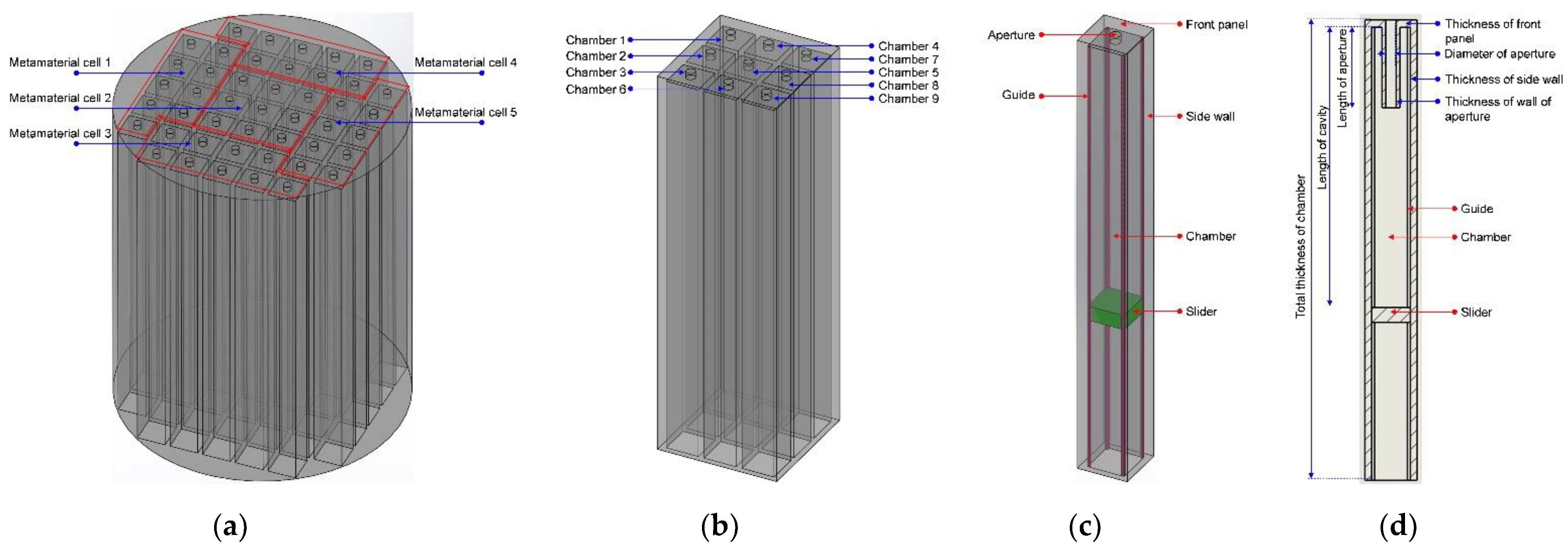

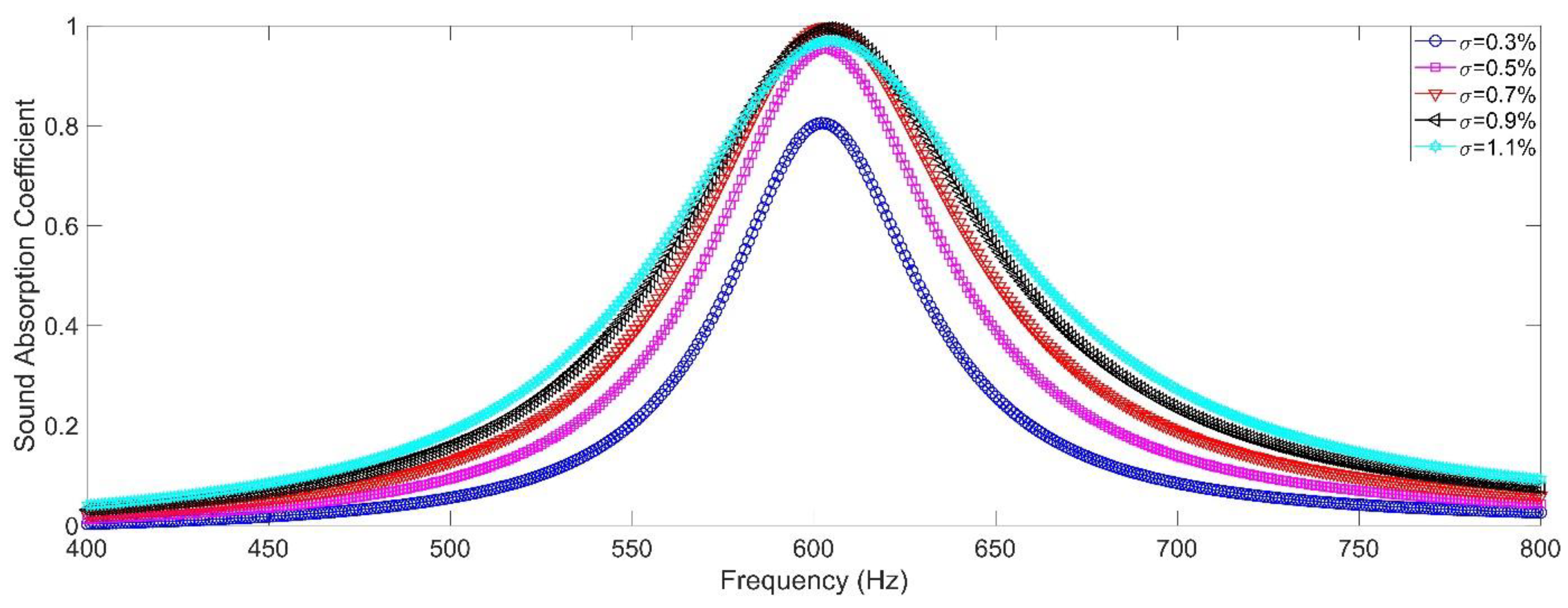
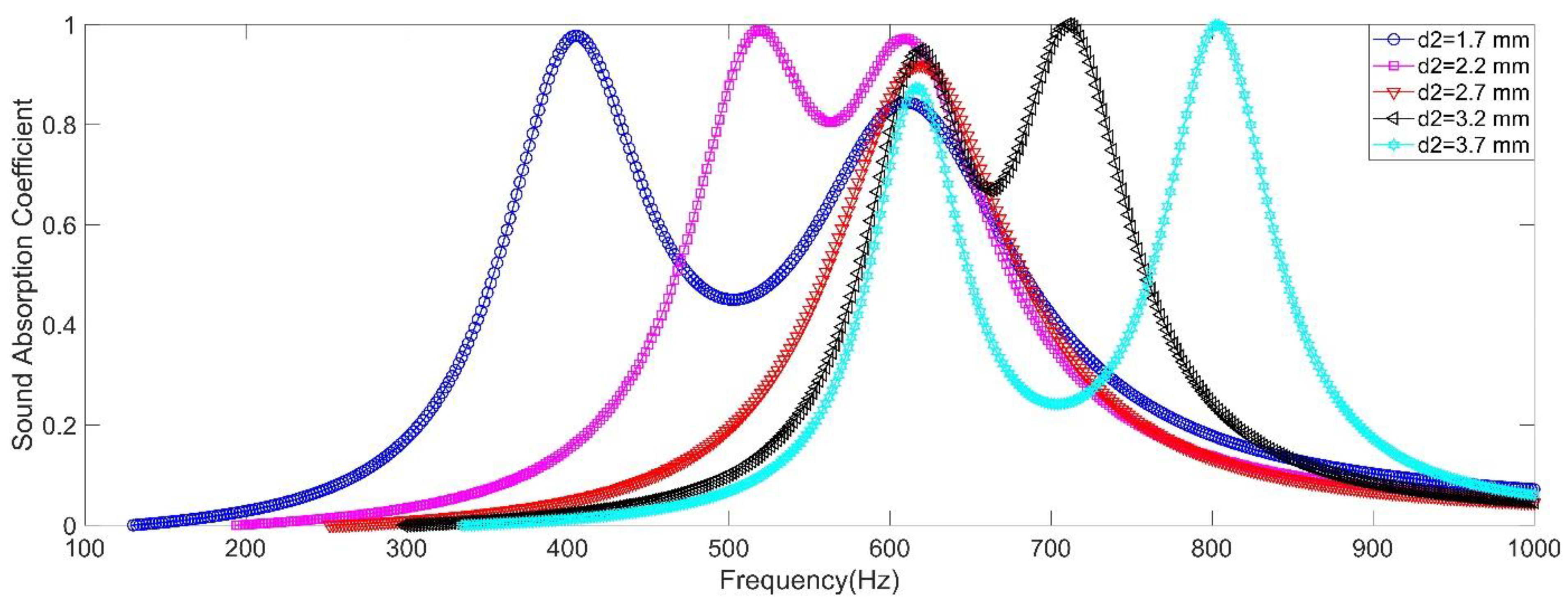
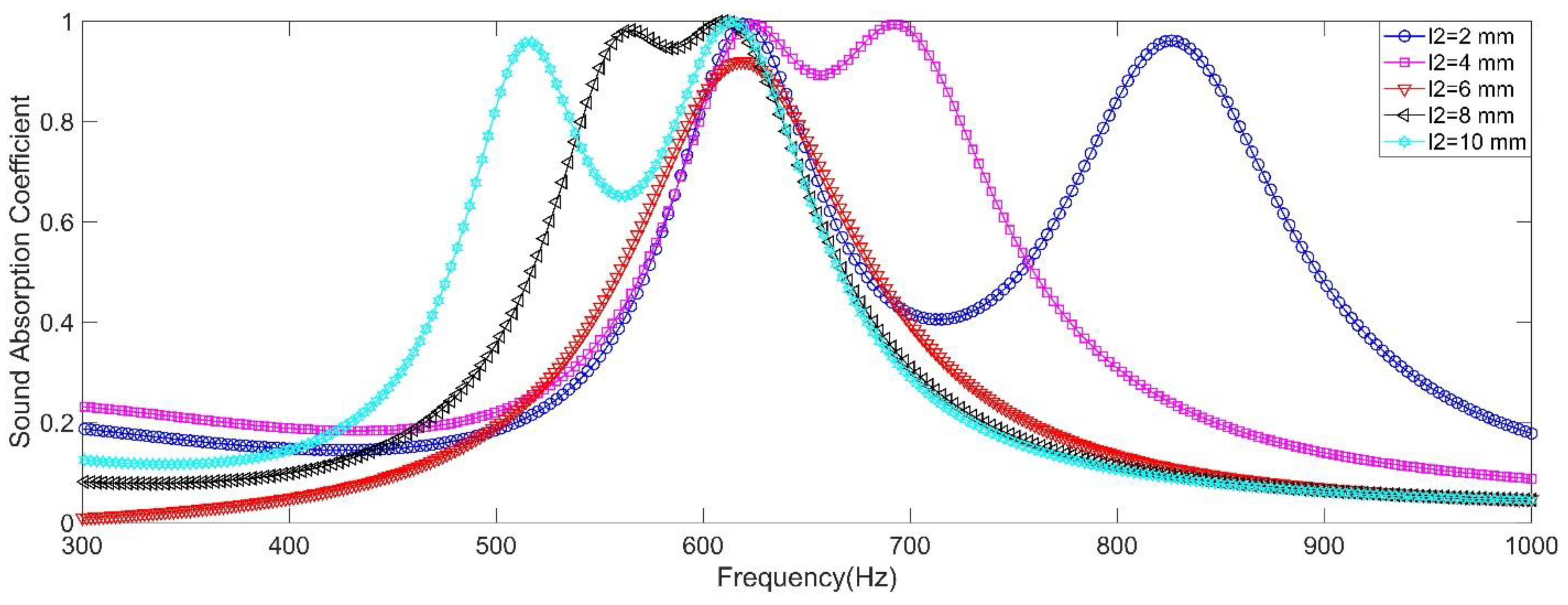
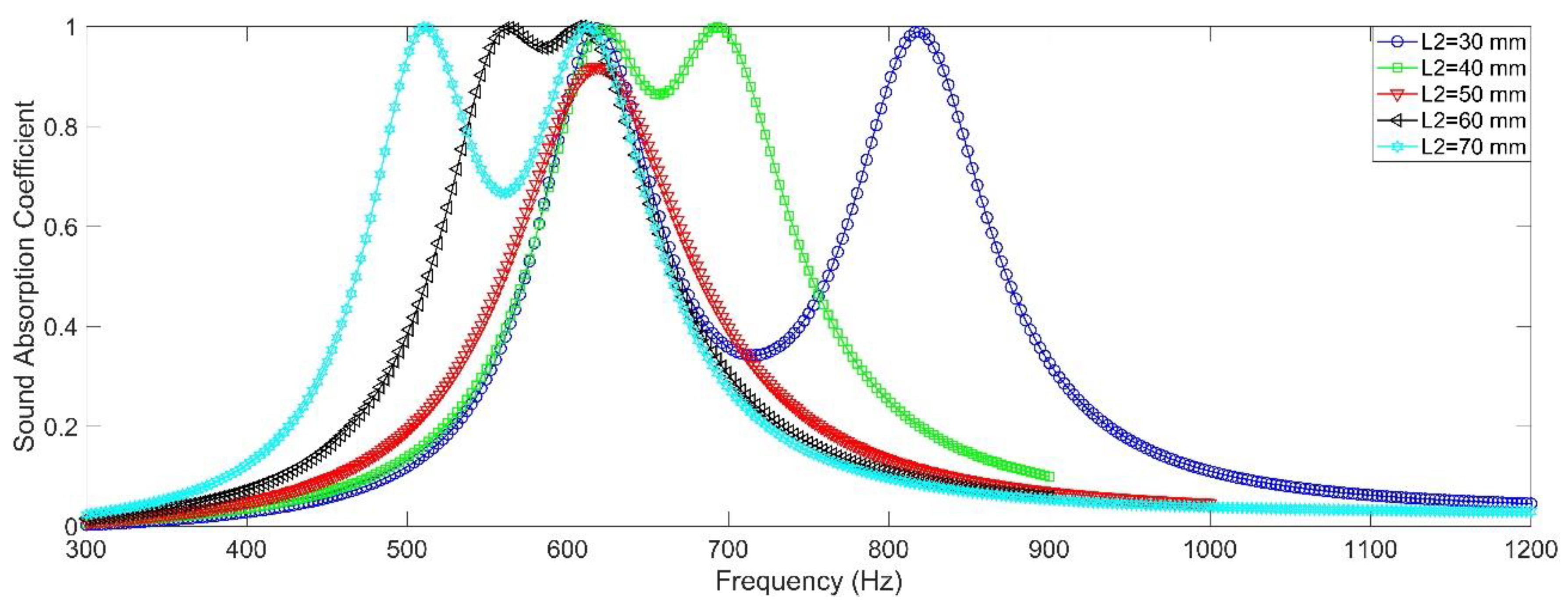

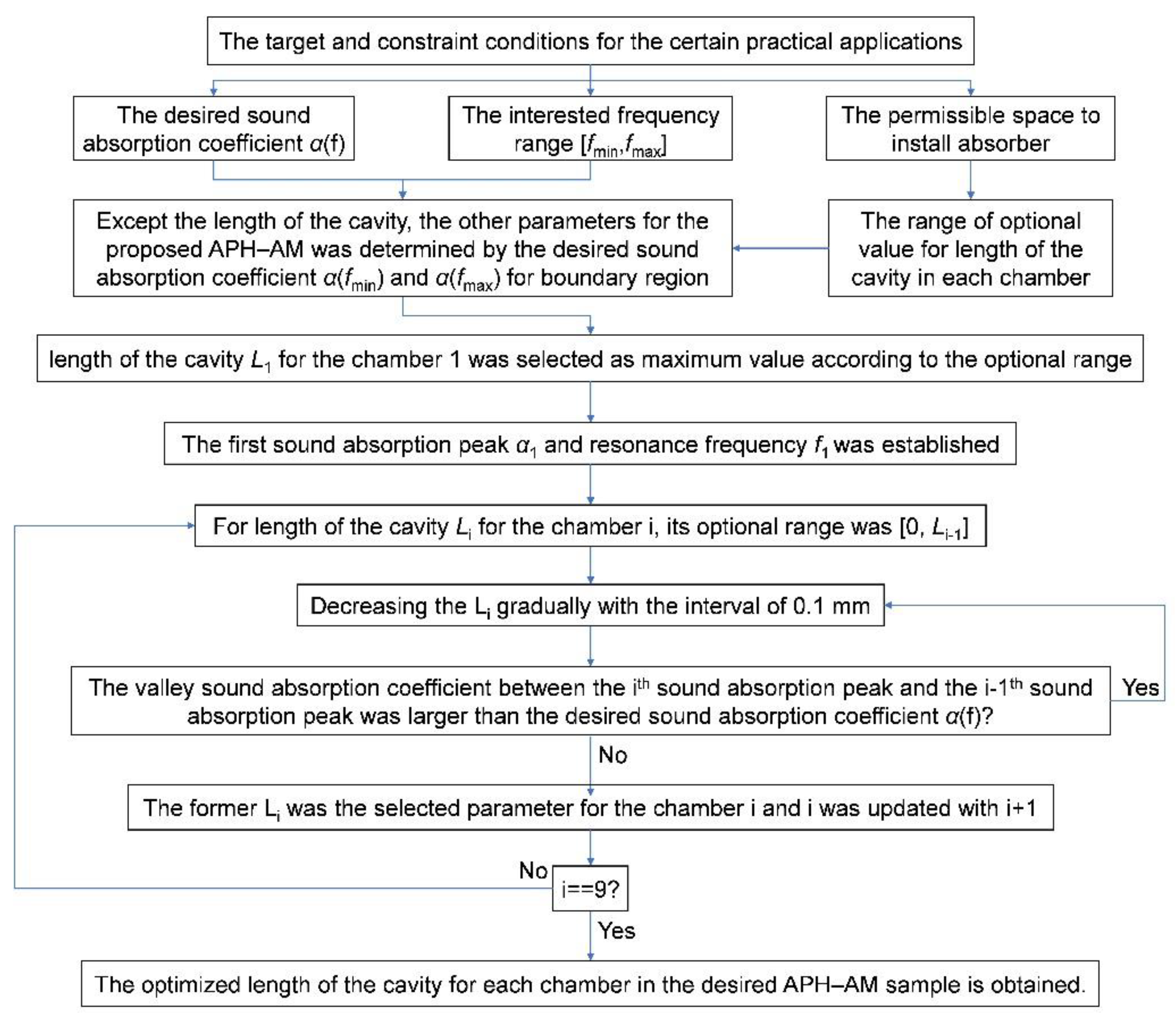

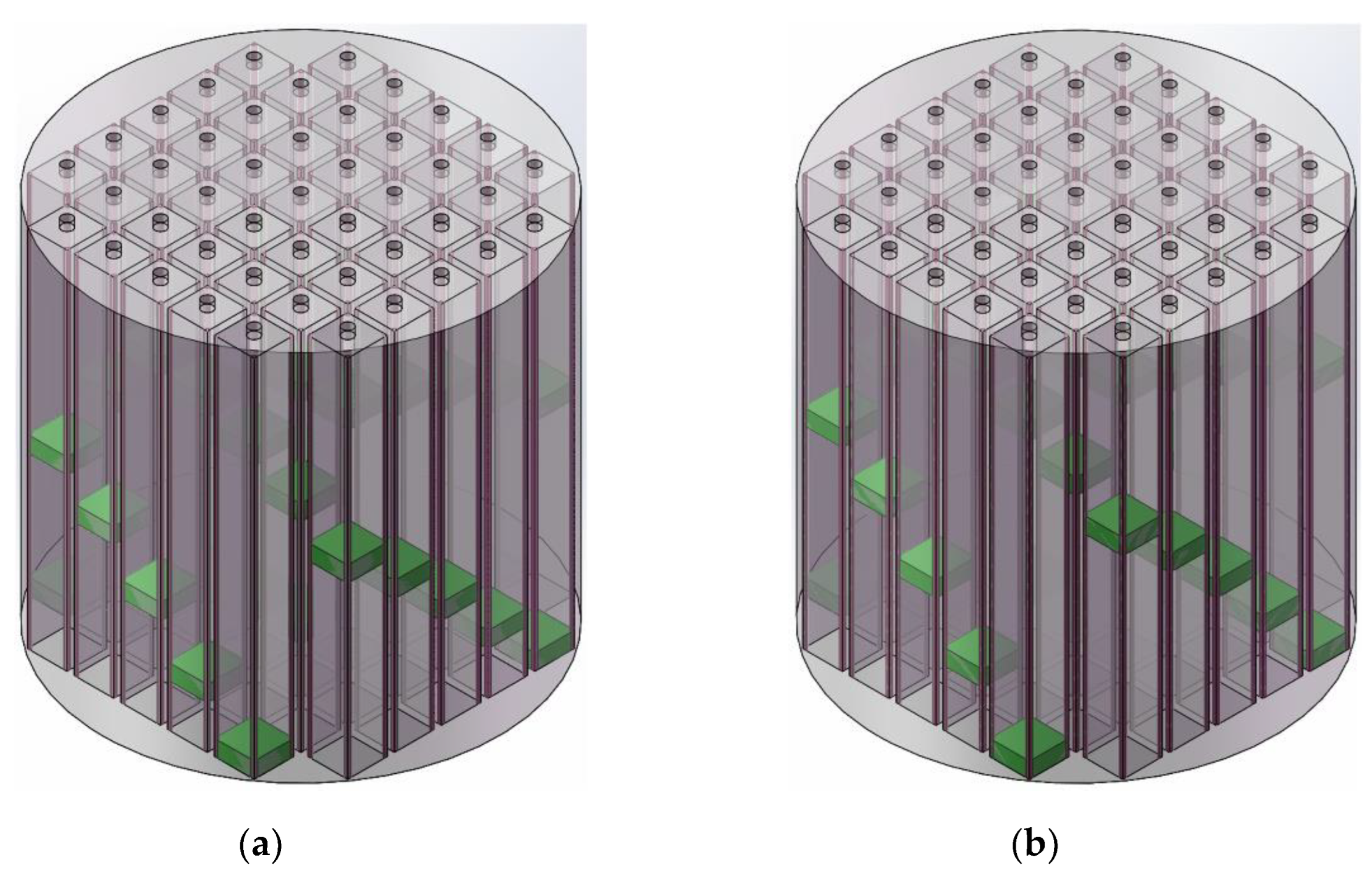

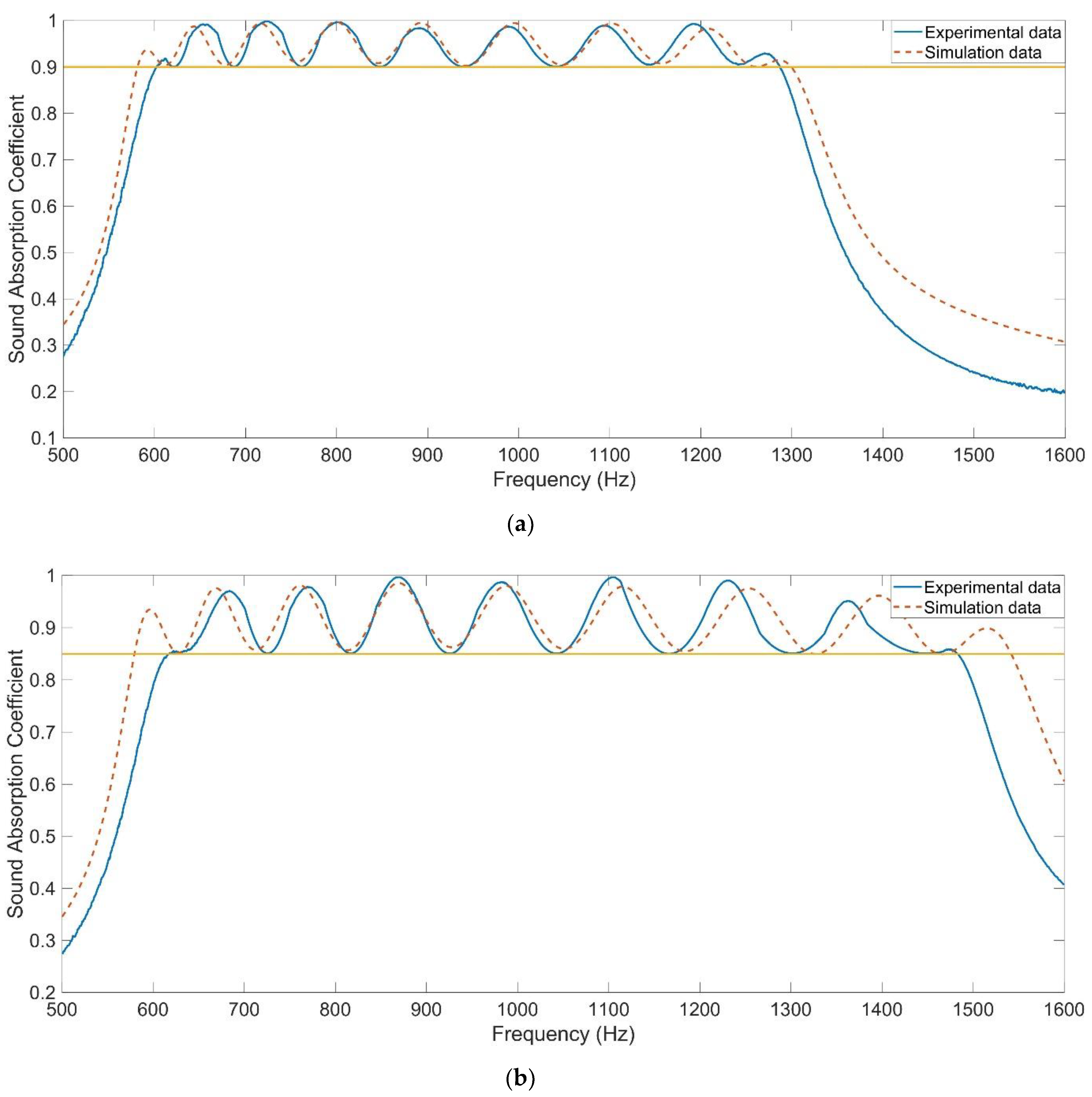
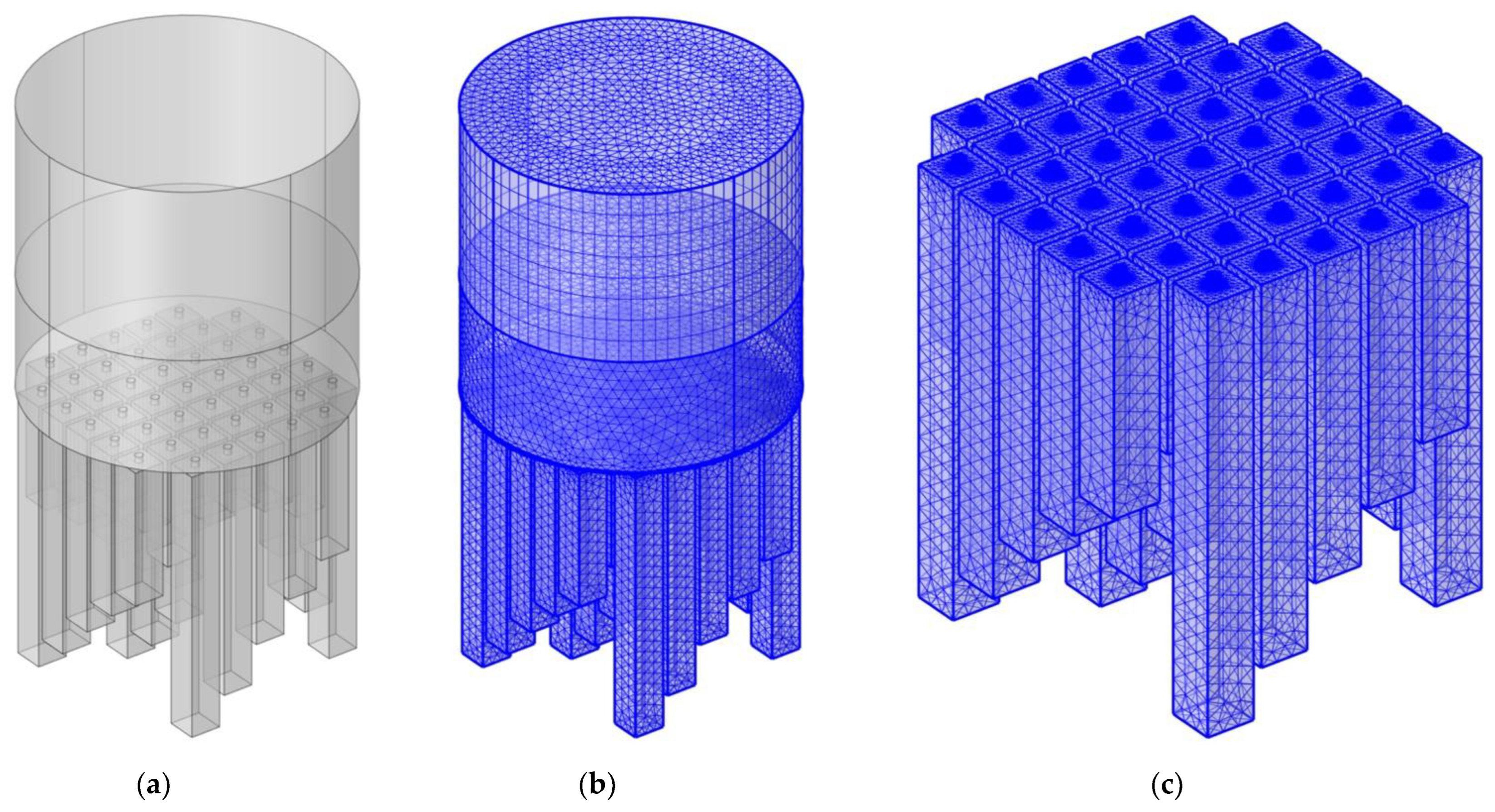

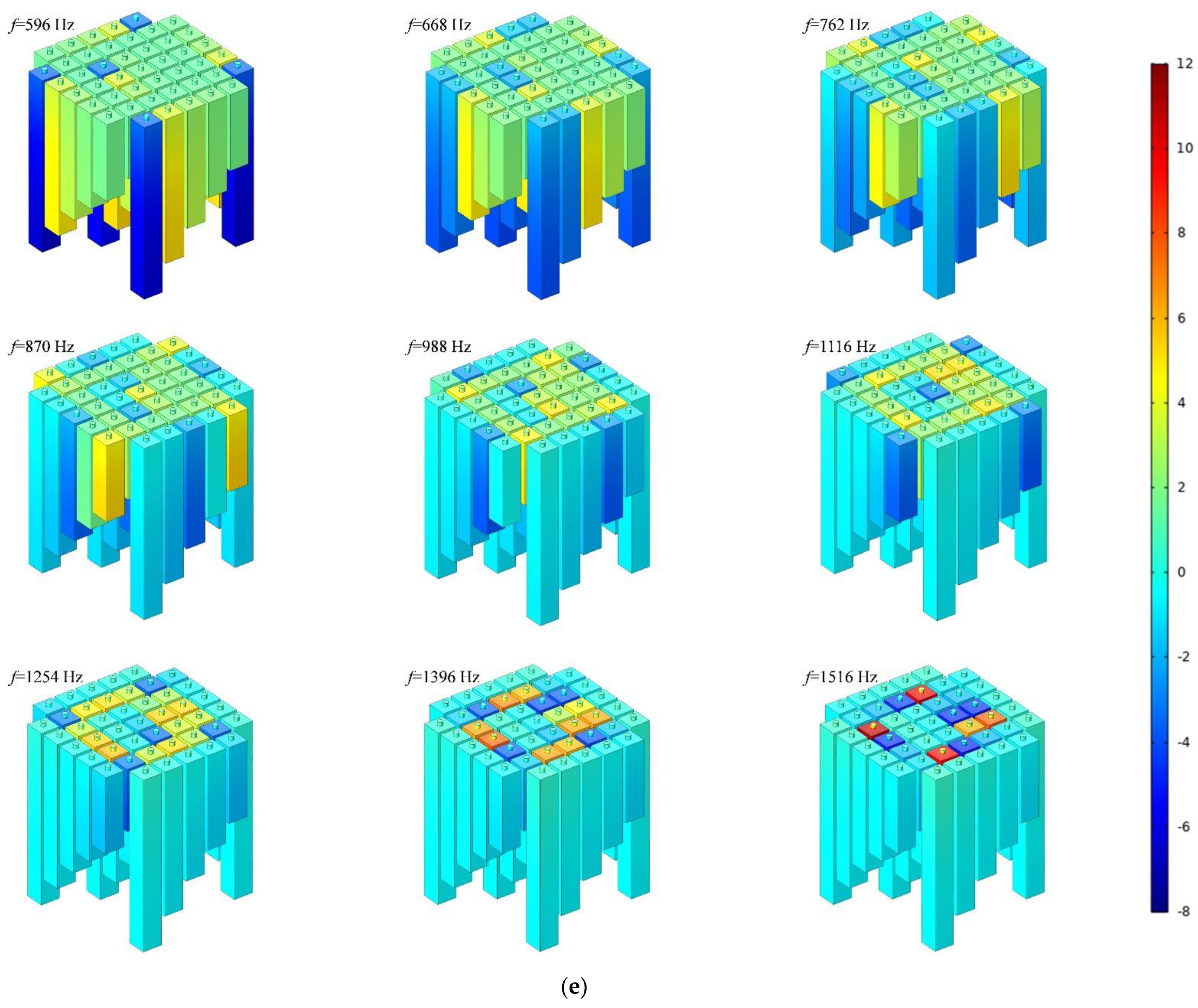



| Parameters | First Absorption Peak | Second Absorption Peak | |||
|---|---|---|---|---|---|
| d1 | d2 | f0 | αmax | f0 | αmax |
| 2.7 mm | 1.7 mm | 610 Hz | 0.84 | 404 Hz | 0.98 |
| 2.7 mm | 2.2 mm | 610 Hz | 0.97 | 520 Hz | 0.99 |
| 2.7 mm | 2.7 mm | 618 Hz | 0.92 | 618 Hz | 0.92 |
| 2.7 mm | 3.2 mm | 618 Hz | 0.95 | 710 Hz | 0.99 |
| 2.7 mm | 3.7 mm | 616 Hz | 0.87 | 804 Hz | 0.99 |
| Parameters | First Absorption Peak | Second Absorption Peak | |||
|---|---|---|---|---|---|
| l1 | l2 | f0 | αmax | f0 | αmax |
| 6 mm | 2 mm | 619 Hz | 0.99 | 826 Hz | 0.96 |
| 6 mm | 4 mm | 625 Hz | 0.99 | 691 Hz | 0.99 |
| 6 mm | 6 mm | 618 Hz | 0.92 | 618 Hz | 0.92 |
| 6 mm | 8 mm | 610 Hz | 0.99 | 565 Hz | 0.98 |
| 6 mm | 10 mm | 613 Hz | 0.99 | 517 Hz | 0.96 |
| Parameters | First Absorption Peak | Second Absorption Peak | |||
|---|---|---|---|---|---|
| L1 | L2 | f0 | αmax | f0 | αmax |
| 50 mm | 30 mm | 618 Hz | 0.99 | 819 Hz | 0.99 |
| 50 mm | 40 mm | 621 Hz | 0.99 | 693 Hz | 0.99 |
| 50 mm | 50 mm | 618 Hz | 0.92 | 618 Hz | 0.92 |
| 50 mm | 60 mm | 615 Hz | 0.99 | 564 Hz | 0.99 |
| 50 mm | 70 mm | 615 Hz | 0.99 | 510 Hz | 0.99 |
| Parameters | First Absorption Peak | Second Absorption Peak | |||
|---|---|---|---|---|---|
| a1 | a2 | f0 | αmax | f0 | αmax |
| 10 mm | 6 mm | 618 Hz | 0.99 | 974 Hz | 0.95 |
| 10 mm | 8 mm | 620 Hz | 0.99 | 756 Hz | 0.99 |
| 10 mm | 10 mm | 618 Hz | 0.92 | 618 Hz | 0.92 |
| 10 mm | 12 mm | 612 Hz | 0.99 | 522 Hz | 0.99 |
| 10 mm | 14 mm | 614 Hz | 0.99 | 446 Hz | 0.99 |
| Target | Parameters (mm) | ||||||||
|---|---|---|---|---|---|---|---|---|---|
| L1 | L2 | L3 | L4 | L5 | L6 | L7 | L8 | L9 | |
| Each α above 0.9 | 90 | 79.2 | 67.2 | 56.5 | 47.2 | 39.7 | 33.4 | 28.6 | 25.6 |
| Each α above 0.85 | 90 | 75.9 | 62.2 | 50.7 | 41.1 | 33.9 | 27.9 | 23.2 | 20.2 |
| Serial Number of Sound Absorption Peak | Peak Sound Absorption Coefficient αmax | Resonance Frequency f0 | |||||
|---|---|---|---|---|---|---|---|
| In Actual | In Simulation | Deviation | In Actual | In Simulation | Deviation | ||
| Target with α above 0.9 | 1 | 0.9185 | 0.9375 | −0.0190 | 611.6 | 592 | 19.6 |
| 2 | 0.9908 | 0.9874 | 0.0034 | 651.1 | 644 | 7.1 | |
| 3 | 0.9983 | 0.9943 | 0.0040 | 723.6 | 716 | 7.6 | |
| 4 | 0.9966 | 0.9974 | −0.0008 | 800.5 | 800 | 0.5 | |
| 5 | 0.9835 | 0.9952 | −0.0117 | 889.9 | 892 | −2.1 | |
| 6 | 0.9869 | 0.9947 | −0.0078 | 988.8 | 994 | −5.2 | |
| 7 | 0.9894 | 0.9937 | −0.0043 | 1094.2 | 1102 | −7.8 | |
| 8 | 0.9929 | 0.9826 | 0.0103 | 1192.3 | 1208 | −15.7 | |
| 9 | 0.9294 | 0.9145 | 0.0149 | 1270.1 | 1286 | −15.9 | |
| Target with α above 0.85 | 1 | 0.8552 | 0.9348 | −0.0796 | 622.6 | 596 | 26.6 |
| 2 | 0.9702 | 0.9758 | −0.0056 | 684.1 | 668 | 16.1 | |
| 3 | 0.9779 | 0.9809 | −0.0030 | 769.8 | 762 | 7.8 | |
| 4 | 0.9967 | 0.9858 | 0.0109 | 870.1 | 870 | 0.1 | |
| 5 | 0.9873 | 0.9801 | 0.0072 | 982.2 | 988 | −5.8 | |
| 6 | 0.9965 | 0.9788 | 0.0177 | 1106.8 | 1116 | −9.2 | |
| 7 | 0.9903 | 0.9754 | 0.0149 | 1232.2 | 1254 | −21.8 | |
| 8 | 0.9512 | 0.9613 | −0.0101 | 1362.1 | 1396 | −33.9 | |
| 9 | 0.8585 | 0.8987 | −0.0402 | 1474.9 | 1516 | −41.1 | |
Publisher’s Note: MDPI stays neutral with regard to jurisdictional claims in published maps and institutional affiliations. |
© 2022 by the authors. Licensee MDPI, Basel, Switzerland. This article is an open access article distributed under the terms and conditions of the Creative Commons Attribution (CC BY) license (https://creativecommons.org/licenses/by/4.0/).
Share and Cite
Yang, X.; Yang, F.; Shen, X.; Wang, E.; Zhang, X.; Shen, C.; Peng, W. Development of Adjustable Parallel Helmholtz Acoustic Metamaterial for Broad Low-Frequency Sound Absorption Band. Materials 2022, 15, 5938. https://doi.org/10.3390/ma15175938
Yang X, Yang F, Shen X, Wang E, Zhang X, Shen C, Peng W. Development of Adjustable Parallel Helmholtz Acoustic Metamaterial for Broad Low-Frequency Sound Absorption Band. Materials. 2022; 15(17):5938. https://doi.org/10.3390/ma15175938
Chicago/Turabian StyleYang, Xiaocui, Fei Yang, Xinmin Shen, Enshuai Wang, Xiaonan Zhang, Cheng Shen, and Wenqiang Peng. 2022. "Development of Adjustable Parallel Helmholtz Acoustic Metamaterial for Broad Low-Frequency Sound Absorption Band" Materials 15, no. 17: 5938. https://doi.org/10.3390/ma15175938





